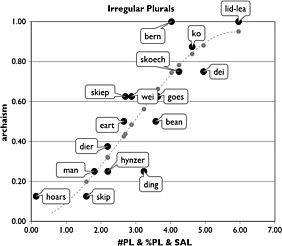Why is it that certain irregular phenomena are preserved longer in language than others? Arjen Versloot and Eric Hoekstra have written an article about conservative forces in language for the scientific journal Morphology. A summary can be found here.
The earlier declensional classes of Old Frisian had gradually been worn down towards the close of the Middle Ages, leaving only incidental lexical vestiges. One of these vestiges is a set of 15 nouns, which still show archaic, but synchronically irregular, plural forms in the early 17th century. We traced their development throughout the following centuries. Only eight of them preserve their 17th century plural form in the written language until the 20th century and even fewer are intact in present-day spoken Frisian. Statistical analyses were performed to find out which factors correlate with retention. It turns out that the absolute and proportional frequencies of the plural form, as well as the salience of the ending, contribute in almost equal proportions to the retention of the plural form. The diachronic regularisation of the studied lexical items can to a large extent be predicted from these 3 variables.
Bibliography
Hoekstra, E. & Versloot, A.P. (2018) Factors promoting the retention of irregularity. On the interplay of salience, absolute frequency and proportional frequency.
doi.org/10.1007/s11525-018-9334-2
http://link.springer.com/article/10.1007/s11525-018-9334-2

